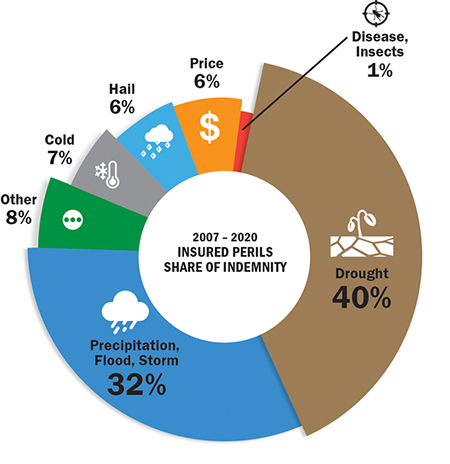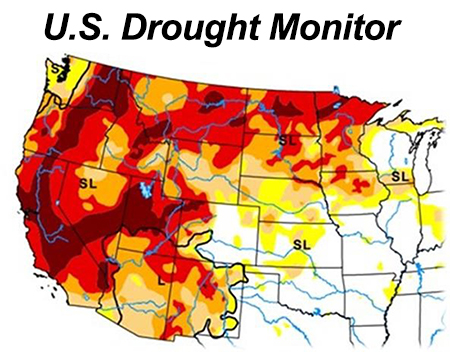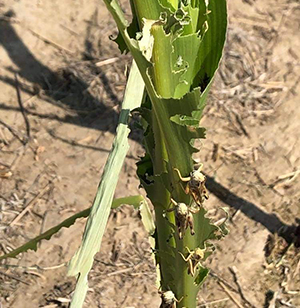May 27, 2022
Lately I have enjoyed getting out to D.C. and talking to our elected officials, meeting with our public and private partners, and coordinating important matters to meet the needs of farmers and ranchers nationwide.
Back at my home in South Dakota, dry weather this past spring led to a slight worsening of drought conditions. Drought is the peril which prompts the most insurance claims every year. From 2007 – 2020 drought accounted for 40 percent of all federal crop insurance indemnities.

Across the Northern Plains it’s an ever-present threat to agriculture and something our Billings Regional Office in Montana works hard to address with growers and livestock producers. In their region, which covers Montana, North Dakota, South Dakota, and Wyoming, there were about 120,000 crop and livestock polices with a liability of about $15.9 billion in 2021. There were roughly 64,000 polices that were indemnified with more than $3 billion paid in claims.

The US Drought Monitor from August 2021 shows the extent of severe drought that devastated much of the west
I recently spoke with Eric Bashore, Director of RMA’s Billings Regional Office. Eric assumed his current role of leading the team in 2014 but has been with our agency since 2001. Prior to joining RMA, he worked for several years for the Farm Service Agency in Michigan and Wyoming. He holds a Master of Arts in Agricultural Economics from Washington State University. I wanted to find out from him what it’s like to serve such a large geographic area, where crop insurance is truly an indispensable necessity.
Marcia: Your office in Billings dealt with a historic drought during the 2021 crop year, a continuation of severe drought during 2020. When disaster struck, what were the major challenges your team faced?
Eric: Our office received many questions about crop insurance options for the ongoing drought. Concern was shared by stakeholders and NCIS State and Regional Loss Committees. Questions the Billings Region received involved things such as the notice of loss process, the early release of crops for livestock feed purposes after crop appraisals occurred or representative sample areas (check strips) were left, cover crop usage for livestock feed purposes, Livestock Risk Protection ownership restrictions and having to sell livestock early, and the $200,000 Indemnity Review process.

Eric Bashore, Director, RMA Billings Regional Office
Marcia: That’s quite a workload for your staff to carry.
Eric: Yes. And that is why partnerships and coordination are key. We worked through National Crop Insurance Services (NCIS) State and Regional loss committees to provide clarity for drought related loss adjustment. We also worked with stakeholder groups to answer drought related questions. This led to updating the Crop Insurance and Drought-Damaged Crops FAQ. Additionally, Richard Flournoy, Acting Administrator during this time, visited North Dakota. During the July 2021 drought tour, Richard and I met with several grower groups and listened to congressional concerns. From this drought tour of North Dakota, we issued bulletins to streamline loss adjustment requirements, accelerate drought relief, and alleviate some challenges with livestock policies due to the unprecedented impact. These actions were part of the coordinated agency response.
Marcia: What is the most important thing your team does in situations like this?
Eric: Listening. At the regional office level, many times, we are the frontline contact for producers, grower groups, and stakeholders. During the 2021 drought, the Billings Regional Office received many phone calls of concern, worry, and turmoil. Team members in the office were able to summarize drought crop insurance options for producers and provide training to stakeholders. They were also able to direct producers and stakeholders to drought relief resources and keep them updated as additional resources were released.

In Montana, drought stunts corn growth and brings millions of grasshoppers clinging to stalks
Photo: Nancy Garoutte, Weldon, MT, August 3, 2021
Marcia: Well, it seems RMA will always have our work cut out for us in the Northern Plains, where our services truly ensure the livelihood of so many communities.
Eric: For sure. As we have moved into the 2022 crop year, our region is once again listening to concerns. There are still drought-impacted areas of the region and concerns that it will continue through the summer months. There have also been several adverse weather events such as blizzards, dust storms, and flooding in eastern Montana, North Dakota, and South Dakota. Excess moisture from these events present concerns for prevented planting and planting crops during the late planting period in some regions.
**
I’m grateful to Eric and his dedicated team for their hard work, skill, and expertise. They are very fortunate to have members from various agricultural backgrounds. The diversity in the Billings Regional Office contributed greatly to the timely and efficient response during the 2021 drought. Their work ethic and tenacity are immensely appreciated.
If you are a farmer or rancher in the Dakotas, Montana, or Wyoming you can reach out to Eric’s office, or the RMA office serving your area, through our website. And be sure to use our agent locator tool if you have specific questions about insurance policies and considering coverage.
– Marcia

Marcia Bunger is the Administrator of USDA’s Risk Management Agency (RMA). Prior to her appointment, she served as a County Executive Director for USDA’s Farm Service Agency. A native South Dakotan, Bunger is also the owner and operator of a 2000-acre farm, a cum laude graduate of Augustana College, and the first member of the Asian American and Pacific Islander community and first woman to serve as RMA Administrator.
